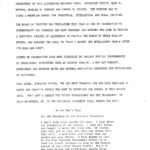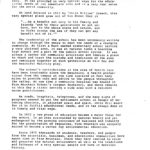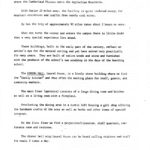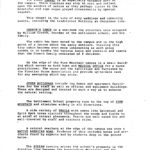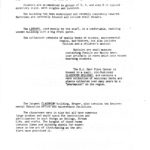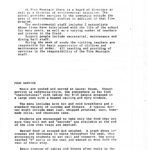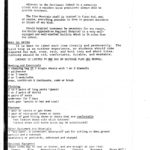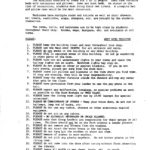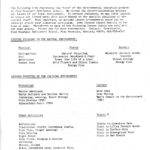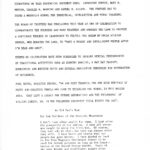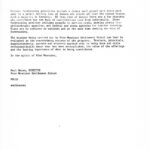Pine Mountain Settlement School
Series 01: HISTORIES
Series 04: ADMINISTRATION
Series 16: EVENTS
Series 22: ENVIRONMENTAL EDUCATION
Paul Hayes
Remarks on 75th Anniversary of PMSS 1988
Student Orientation, Policies, and Programs
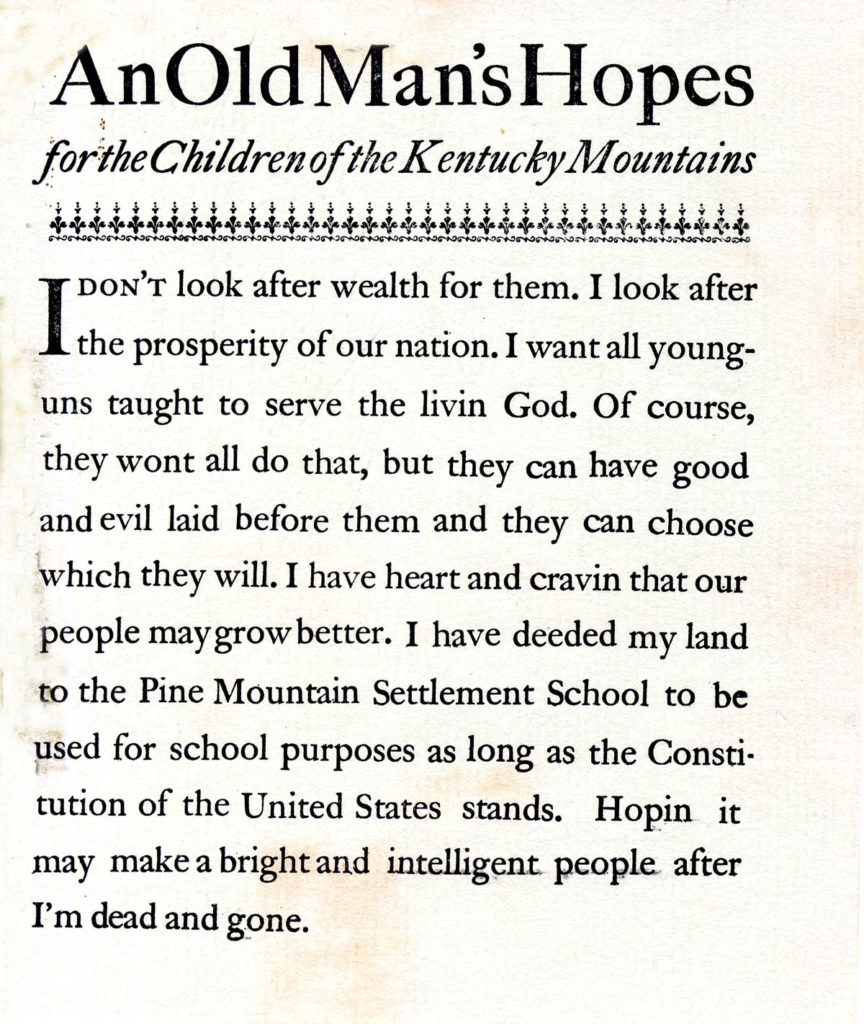
“An Old Man’s Hopes” by William Creech. [1959_calendar_001.jpg]
TAGS: 75th Anniversary of PMSS founding, Paul Hayes, PMSS history, William Creech, Articles of Incorporation, West Wind visitor policies, visitor guide, Environmental Education, EE Programming, built environment, student orientation, Pine Mountain Settlement School, Harlan County KY
PAUL HAYES Remarks on 75th Anniversary of PMSS 1988
On the occasion of the 75th Anniversary of Pine Mountain Settlement School in 1988, Director Paul Hayes drafted the following news release:
NEWS RELEASE
PINE MOUNTAIN SETTLEMENT SCHOOL 75TH ANNIVERSARY
On January 9, 1913, at Gratz House in Lexington, Kentucky, the Articles of Incorporation establishing Pine Mountain Settlement School was signed. Signatures on this historical document were: Katherine Pettit, Mary B. Morton, Charles N. Manning, and Samuel M. Wilson. The purpose was to found a mountain school for industrial, intellectual and moral training.
The Board of Trustees has proclaimed this year as one of celebration to commemorate the founders and many teachers and workers who provided a continuous process of leadership to fulfill the dream of Uncle William Creech, who donated the land for a school “to make a bright and intelligent people after I’m dead and gone.”
In 1988, events were scheduled to celebrate the 75th anniversary of the 1913 meeting to include special performances of traditional activities such as country dancing, a May Day pageant, Homecoming and reunion skits, and several dedication ceremonies for the restoration of buildings.
Paul Hayes, Director states, “We are most thankful for our rich heritage of hardy and creative people who came to establish the school in this rugged area. They left a legacy for future generations and the philosophy of William Creech, Sr. in the following statement still points the way.”
AN OLD MAN’S HOPE
for the Children of the Kentucky Mountains
I don’t look after wealth for them. I look after the prosperity of our nation. I want all young-uns taught to serve the Livin God. Of course, they won’t all do that, but they can choose which they will. I have heart and cravin’ that our people may grow better. I have deeded my land to the Pine Mountain Settlement School to be used for school purposes as long as the Constitution of the United States stands. Hopin‘ it may make bright and intelligent people after I’m dead and gone.
From a Letter by
William Creech, Sr., 1913
Pine Mountain, Kentucky
STUDENT ORIENTATION: History, Campus Description, Student Services and Policies, Lesson Topics
The following are Director Paul Hayes’ history of PMSS, descriptions of the School’s campus, student policies, and educational programs:
HISTORY
Pine Mountain Settlement School has a fascinating history. It has provided in very special ways for the educational needs of its immediate area and in a very real sense for the world community.
In [on land donated in 1913 by “Uncle William” Creech, this very special place grew out of his dream that it
“.. be a benefit not only to his family and friends and to their generations as yet unborn, but to the whole state and nation, and to folks across the sea if they can get any benefit out of it.
William Creech, “An Old Man’s Hopes.”
The leadership of the school has been uncommonly willing to change through the year to meet the needs of a changing community. At first, a much needed elementary school serving a very isolated area, it was at various times a boarding high school and a part of the public school system. It was always a center for community activities and remains a place to teach and learn the customs and traditions of the area and reminisce together at such gatherings as Fair Day and the beautiful Nativity Play.
The school’s contributions in the area of health care have been invaluable since the beginning. A health professional from the campus at one time traveled on foot many miles to provide care and advice to the people throughout the valley. At one time a community hospital was housed in Pine Mountain School’s largest dormitory, [West Wind] and there remains to this day a clinic serving a wide area with a resident nurse practitioner.
As roads, hospitals, telephones, and the many signs of progress seemed to put the settlement school in danger of becoming obsolete, it adjusted again and again. Uncle Will meant for it to fulfill educational needs, and it has always done so in timely and vital ways.
In 1972 a new phase of education became a major focus for the school. IN an area surrounded by natural beauty and yet endangered by the growing unconcern of business and industry for the preservation of resources, Pine Mountain was uniquely suited to become a center for environmental education.
Since 1972 thousands of students, teachers, and people from the scientific, business, and educational communities have spent time at Pine Mountain. There they have learned to value and preserve the natural environment as well as the traditions and folkways of a very special people and time in American history.
LOCATION AND DESCRIPTION OF CAMPUS
North and east of Harlan, Kentucky, where route 221 meets route 501, Pine Mountain Settlement School is located at the foot of Pine Mountain where the Cumberland Plateau meets the Appalachian Mountains.
With Harlan 22 miles away, the facility is quite isolated except for mountain residences and traffic from nearby coal mines.
By bus, the trip of approximately 90 miles takes about 2 hours or more.
When one turns the corner and enters the campus there is little doubt that a very special experience lies ahead.
These buildings, built in the early part of the century, reflect an artist’s eye for the natural setting and yet have served very practically for many years. They are built of native woods and stone and furnished with the products of the school’s own wood shop in the days of the boarding school.
The DINING HALL, Laurel House [II], is a lovely stone building where we find the “family kitchen” and thus often the meeting place for staff, guests, and community members.
The main floor (upstairs) consists of a large dining room and kitchen as well as a living room with a fireplace.
Overlooking the dining area is a rustic loft housing a gift shop offering the handmade crafts of the area as well as books and other items of special interest.
On the first floor we find a projection/classroom, staff quarters, conference room, and restroom.
The dinner bell atop Laurel House [II] can be heard calling visitors and staff for meals 3 times a day.
The stone CHAPEL is an especially valuable part of the campus. There, visitors may stop to rest and reflect upon the wonders of nature as they perhaps listen to the beautiful old pipe organ played occasionally by special request.
This chapel is the site of many weddings and community events, including the traditional Nativity at Christmas time.
CREECH’S CABIN [Aunt Sal’s Cabin] is a one-room log structure once occupied by William Creech, founder of the settlement school, and his family.
The cabin has been moved to the campus and is the high point of a lesson about the early settlers. Visiting this tiny cabin becomes even more interesting as each group crowds in to handle the various tools and utensils and learns that the Creech family consisted of 8 children.
On the edge of the Pine Mountain campus is a small building that serves as both home and MEDICAL OFFICE [Old Log] for a nurse practitioner. The nurse and the facilities are furnished by the Frontier Nursing Association and provide up-to-date care for any emergency which may arise.
OTHER BUILDINGS include log homes and apartment facilities for the staff as well as offices and equipment buildings. These are designed and located in such a way as to enhance the natural setting.
The Settlement School property runs to the top of PINE MOUNTAIN and stretches widely in all directions,.
A wide variety of TRAILS with names like Spicebush and Split Rock takes visitors throughout the woods and fields to an array of natural phenomena. Trails are well cared for and well-traveled by staff and visitors alike.
A natural overhang at the edge of the campus was once a NATIVE AMERICAN HOME [Indian Cliff]. Evidence of this includes bones and artifacts found by experts and by students deep in the ground below.
The STREAM [Isaac’s Creek or Isaac’s Run] running across the school’s property is the dividing line between the Appalachian Mountains and the Cumberland Plateau. This, of course, provides a unique setting for the study of Geology.
Westwind [sic], the DORMITORY [West Wind], once served as a community hospital for the people throughout the mountains in the area. It provides three separate floors of rooms as well as a living room with a fireplace.
Students are accommodated in groups of 2, 4, and even 8 in typical dormitory style, with singles and bunk beds.
The building has been modernized and recently completely required. Bathrooms are centrally located and include stall showers.
The LIBRARY [Boy’s House], used mostly by the staff, is a comfortable, rambling wooden building with a big front porch.
The collection consists mostly [of] books on science, environmental topics, and history, but also includes fiction and a children’s section.
Upstairs are small museums containing fossils and Native American artifacts in rooms that once housed boarding students.
The E. J. Carr Plant Center is housed in a small, old-fashioned CLASSROOM BUILDING [Draper Industrial Building], and contains a rare collection of medicinal herbs and plants collected over many years by a “pharmacist” in the region.
The largest CLASSROOM building, Draper, also contains the Environmental Education office and maintenance facilities.
The classrooms vary in size but all have numerous large windows and ample space for instruction and participation in such things as Geology, Stream Life, and crafts. The largest of these rooms contains looms and spinning wheels for experience in the art of cloth-making as the settlers once practiced it.
STAFF
At Pine Mountain, there is a board of directors as well as a director of environmental education. The school provides services to the community outside the area of environmental studies in addition to that fine program.
The environmental staff includes 2 naturalists whose lives have intertwined with the life of the school for many years, as well as a varying number of teachers and intern in the field.
Support people include secretarial, maintenance and dining hall staff.
During the week of study the visiting teachers are responsible for basic supervision of children and maintenance of order. All teaching and providing of services is the responsibility of the Pine Mountain staff.
FOOD SERVICE
Meals are cooked and served at Laurel House. Though serving is cafeteria-style, the atmosphere is far from “institutional” with tables for 8-10 people arranged in a large room with a beamed ceiling and many windows.
The menu includes both hot and cold breakfasts and a standard variety of lunches and dinners. A typical dinner might include meat loaf, whipped potatoes, corn, home-made rolls, and chocolate cake.
Students are encouraged to take only the food they are sure they will eat and “seconds” are available at the end of the line when trays are emptied.
Wasted food is scraped and weighed. A graph shows increases and decreases in waste throughout the week, thus encouraging students to eat well and conserve. One group reached “0” early in the week and wasted no more food the rest of their stay.
Basic cleanup of tables and floors after meals is the responsibility of students in rotating groups, thus promoting pride in cleanliness.
MEDICAL INFORMATION
Adjacent to the Settlement School is a community clinic with a resident nurse practitioner always able to provide treatment.
The Pine Mountain staff is trained in First Aid, and of course, everything possible is done to prevent accidents or injury of any kind.
Should hospital treatment be necessary for any reason, the Harlan Appalachian Regional Hospital is a very well-equipped and well-staffed facility which is 24 miles from the school.
WHAT TO BRING
It is best to label each item clearly and permanently. The field trip is an outdoor experience, so students should come prepared for mud, snow, rain, and both long and short hikes. Clothing should be old, comfortable, durable, and washable.
LUGGAGE IS LIMITED TO ONE BAG OR SUITCASE PLUS ONE BEDROLL.
Bedding and Essentials
1 sleeping bag or 2 single sheets with 1 or 2 blankets
1 pillowcase
2 or 3 towels
2 or 3 washcloths
soap, toothbrush & toothpaste, comb or brush
Clothing
2 to 4 pairs of long pants (jeans)
1 to 2 pairs of shorts
6 pairs of socks
underwear for 5 days
rain gear (poncho or hat and coat)
Footwear
1 pair of tennis or gym shoes
1 pair of rain-proof shoes or boots
1 pair of good hiking shoes or boots that are comfortable
(not fashion boots with slick bottoms)
(tennis shoes with extra socks may be substituted)
Other Equipment and Materials
1 “sit-upon,” a convenient waterproof pad for sitting on damp ground
Pencils and a notebook
Stationary or postcards, addressed and stamped
Optional Equipment
These items may be lost or broken, and brought at your risk:
camera, film, magnifying glass, compass, knapsack, money $15
DO NOT BRING
Snacks, radios, slick-bottomed shoes, knives, electrical appliances
DORM PROCEDURES
The dormitory consists of rooms for 2 to 10 people. Each room contains beds with mattresses and pillows. Some are bunk beds. As stated in the list of necessities,m students must bring their own linens. A sleeping bag and pillow case would be the most convenient.
Bathrooms have multiple sinks and toilets as well as stall showers. All towels, washcloths, soaps, shampoos, etc. are brought by the students themselves.
The rooms, halls, and bathrooms are to be kept clean by students throughout their stay. Brooms, mops, dustpans, etc. are available at all times.
WEST WIND POLICIES
- PLEASE keep the building clean and neat throughout your stay.
- PLEASE use the Main Door (NORTH) for all entrance and exits.
- PLEASE do not smoke in the building or any other building.
- PLEASE stay in assigned areas in this building. Do not go wandering in other parts of the Dorm.
- PLEASE turn out all unnecessary lights in your rooms and leave the hallway lights out at night. Bathroom lights may stay on.
- PLEASE do not sleep on cover or against blankets. If you do not have sheets, please get some from the Dorm Host.
- PLEASE leave all pillows and blankets in the room where you find them. If they are missing, they will be your responsibility.
- PLEASE keep the shower curtains inside the showers and mop any water that gets on the floor.
- PLEASE have permission from your leader to use the payphone in the hall.
- PLEASE report any malfunction, breakage, or similar problems as soon as possible to the Dorm Hostess or PMSS Staff.
- PLEASE have the living room light out by 10:00 (except for special occasions).
- PLEASE BE CONSIDERATE OF OTHERS – keep your voice down, do not run in hallways, jump out of bunks, etc.
- PLEASE do not use any radios, stereos or other electronic musical equipment.
- PLEASE do not sit on any tables.
- PLEASE NO ALCOHOLIC BEVERAGES OR DRUGS ALLOWED.
- PLEASE note that Group Leaders are responsible for their groups at all times, Children should not be in the Dorm without a leader present.
- PLEASE do not remove any screens from the windows.
- PLEASE do not touch the water-hoses in the hallways.
- PLEASE do not hang out the windows or shout out them.
- PLEASE beware of snakes in warm weather.
- PLEASE do no pick any plants anywhere. Do not bother plants in the living room.
- PLEASE do not come into the dorm after caving without first showering at the library.
- PLEASE leave all muddy or wet shoes, boots, etc., on porch.
- ATTN: PLEASE TAKE NOTE: In case of FIRE, exit quickly and quietly at either end of the Main Hall. Proceed along the edge of the road to the lawn of the house below West Wind. (FAR HOUSE)
DO NOT RE-ENTER THE BUILDING UNLESS DIRECTED TO BY PMSS STAFF!!
PINE MOUNTAIN SETTLEMENT SCHOOL LESSON TOPICS
The following list represents the “core” of the environmental education program at Pine Mountain Settlement School. We stress the interrelationships between all facets of our total environment. In certain instances, we may offer lessons on topics not listed here, this would depend on the specific abilities of the current staff. Most important, we welcome lesson arrangements which can be centered around your classroom curriculum. Some lessons depend heavily on the time of year. Variations on many of the following lesson topics are available for most grades. Please ask for more information. Contact: Coordinator, Pine Mountain settlement School, Pine Mountain, Kentucky 40810. 606 558-4361
LESSONS FOCUSING ON THE NATURAL ENVIRONMENT
| PHYSICAL | PLANTS | ANIMALS |
| Geology | Natural Recycling | Wildlife, (Animals, Birds, Insects) |
| Soil | Succession (Woodland & Pond) | Stream Ecology |
| Water/Land | Trees (the life of a tree) | |
| Summit Hike | Wild Flowers ad Edible Plants | |
| Energy Flow | Energy Flow |
LESSONS FOCUSING ON THE CULTURAL ENVIRONMENT
| HISTORICAL | CURRENT |
| Native American | Wood Uses |
| Early Settlers and Settler Skills (Spinning, weaving, board riving) | Coal Mining |
| Folk Stories (TBD) | Man’s Impact on the Environment |
| Appalachian Music (TBD) | (TBD) |
LESSONS FOCUSING ON THE CULTURAL ENVIRONMENT
OTHER ACTIVITIES & VISITS
| OTHER ACTIVITIES | VISITS* |
| Reflections | Visits to Limestone Cave |
| Traditional Crafts (Cornshuck Crafts, Folk Toys, Finger Weavings) | Visit to Lilley Cornett Woods |
| Folk Dancing | Visit to Surface Mine |
| Night Hikes | Visit to Underground Mine |
| Camp Fires – singing & stories | Visit to Bad Branch |
| Astronomy | |
| Movies, Slides | |
| Hikes (Sandstone Cave, Look-out Rock | |
| Discovery |
GALLERY
- Paul Hayes Remarks: 1988 News Release – 75th Anniversary of PMSS. [hayes_paul_75th_001.jpg]
- Paul Hayes Remarks: EE Programming – History. [hayes_p_pmss_hist_001.jpg]
- Paul Hayes Remarks: EE Programming – Location & Description of Campus. [hayes_p_pmss_hist_002.jpg]
- Paul Hayes Remark: EE Programming – Location & Description of Campus, continued. [hayes_p_pmss_hist_003.jpg]
- Paul Hayes Remarks: EE Programming – Location & Description of Campus, continued. [hayes_p_pmss_hist_004.jpg]
- Paul Hayes Remarks: EE Programming – Staff, Food Service. [hayes_p_pmss_hist_005.jpg]
- Paul Hayes Remarks: EE Programming – Medical Information, What to Bring. [hayes_p_pmss_hist_006.jpg]
- Paul Hayes Remarks: EE Programming – Dorm Procedures, West Wind Policies.[hayes_p_pmss_hist_007.jpg]
- Paul Hayes Remarks: Environmental Education Lesson Topics. [hayes_p_pmss_hist_008.jpg]
GALLERY II – Paul Hayes News Release
- hayes_p_pmss_75th__001
- hayes_p_pmss_75th_002
- hayes_p_pmss_75th_003
- hayes_p_pmss_75th_004
See Also:
ENVIRONMENTAL EDUCATION Introduction
ENVIRONMENTAL EDUCATION Guide 1972 to present
NOTES – 1988 November
PAUL HAYES Director Biography

